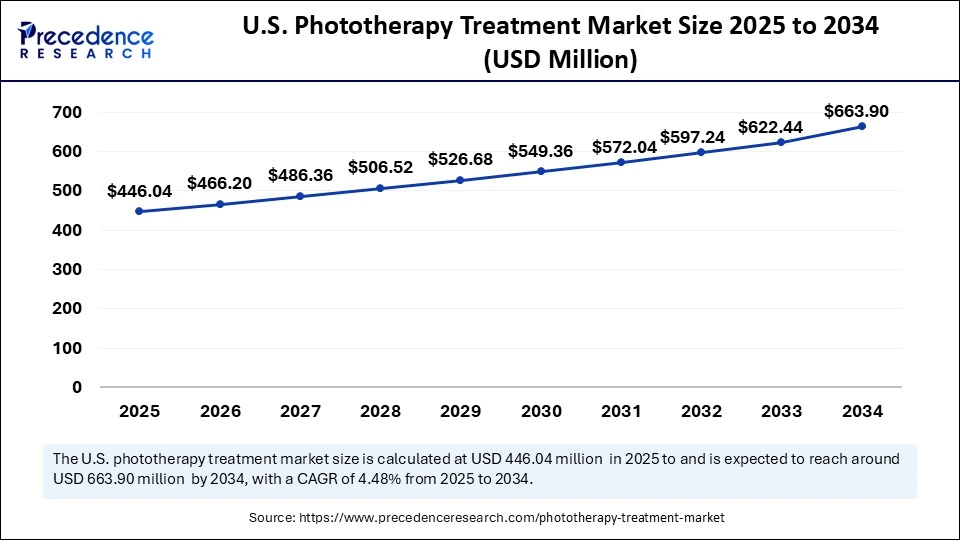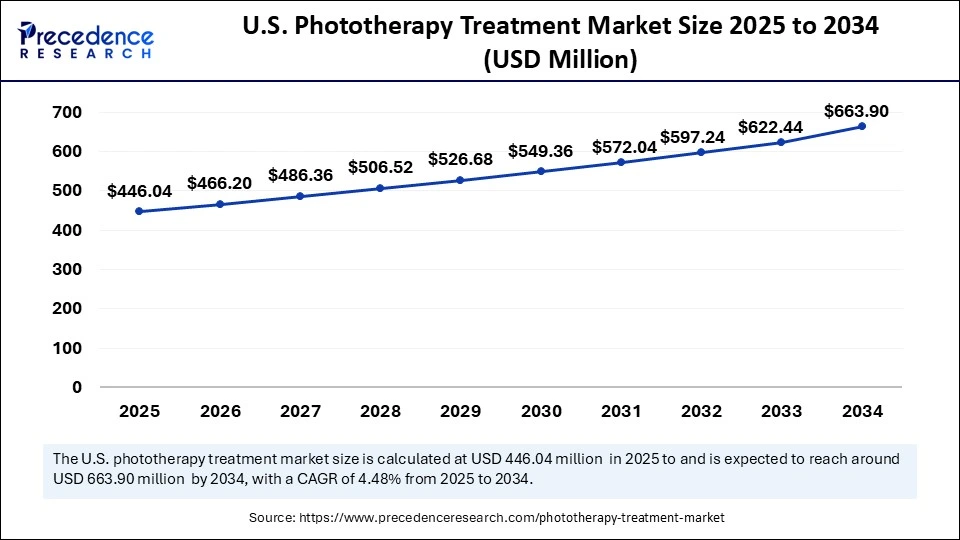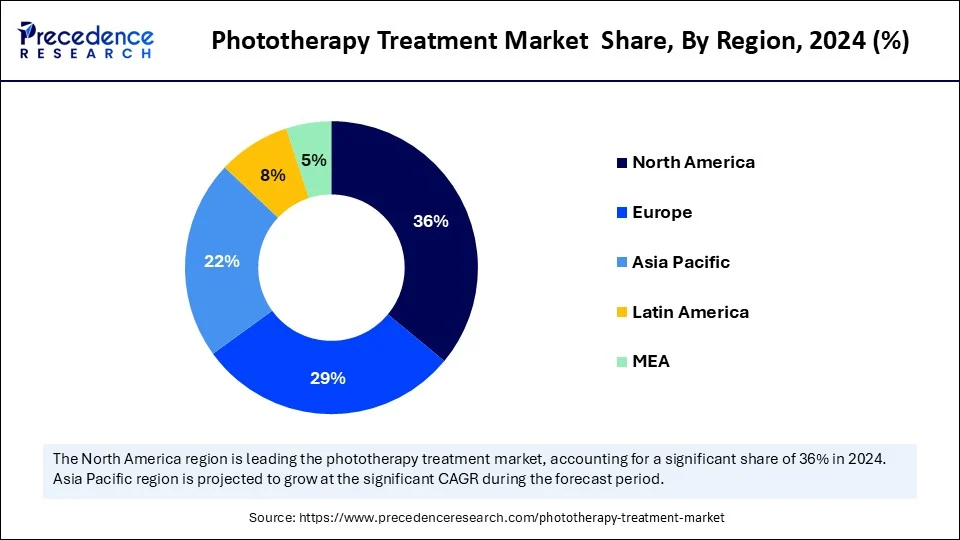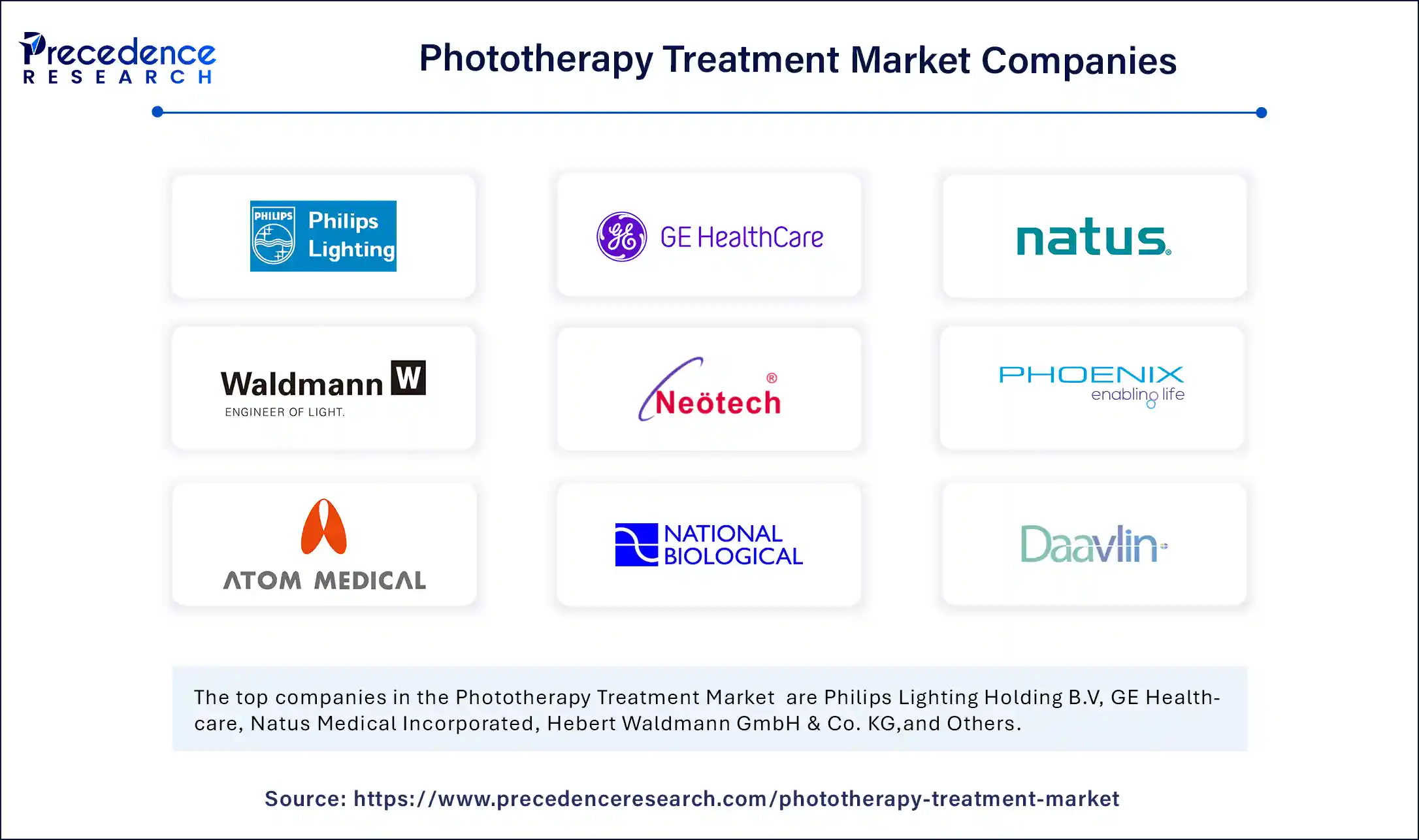List of Contents
Phototherapy Treatment Market Size and Forecast 2025 to 2034
The global phototherapy treatment market size accounted for USD 1.70 billion in 2024 and is predicted to increase from USD 1.77 billion in 2025 to approximately USD 2.58 billion by 2034, expanding at a CAGR of 4.25% from 2025 to 2034. The phototherapy treatment market is driven by the rising prevalence of chronic skin conditions, growing demand for non-invasive therapies, and advancements in light-based technology.

Phototherapy Treatment Market Key Takeaways
- In terms of revenue, the global phototherapy treatment market was valued at USD 1.70 billion in 2024.
- It is projected to reach USD 2.58 billion by 2034.
- The market is expected to grow at a CAGR of 4.25% from 2025 to 2034.
- North America dominated the phototherapy treatment market with largest market share of 36% in 2024.
- Asia Pacific is anticipated to witness the fastest growth during the forecasted years.
- By disease type, the acne segment held a significant share in 2024.
- By disease type, the psoriasis segment is anticipated to show considerable growth over the forecast period.
- By phototherapy type, the blue light therapy segment contributed the biggest market share in 2024.
- By phototherapy type, the psoralens + ultraviolet light phototherapy segment is anticipated to show considerable growth over the forecast period.
How is AI Integration Transforming the Phototherapy Treatment Market?
The integration of artificial intelligence in the phototherapy market is revolutionizing the administration, monitoring, and optimization of light-based therapies, thereby enhancing treatment outcomes. AI-driven technology facilitates real-time monitoring, enabling automatic adjustments to treatment parameters to ensure patient safety. Furthermore, AI supports the development of smart, at-home phototherapy systems, incorporating mobile apps and sensors that guide patients, track progress, provide reminders, and improve compliance and ease of use.
U.S. Phototherapy Treatment Market Size and Growth 2025 to 2034
The U.S. phototherapy treatment market size was exhibited at USD 428.40 million in 2024 and is projected to be worth around USD 663.90 million by 2034, growing at a CAGR of 4.48% from 2025 to 2034.

Why Did North America Dominate the Phototherapy Treatment Market in 2024?
North America dominated the market by capturing the largest share in 2024. This is mainly due to the increased burden of skin diseases like psoriasis, eczema, and acne and the increased consumer awareness about the long-term benefits of phototherapy. Recent technological advancements have produced more effective and user-friendly phototherapy machines. Increased healthcare spending and investment in dermatological research are also key factors driving the market's growth in this area. The region's advanced healthcare system also bolstered the market.
The U.S. is a major player in the North American phototherapy market, driven by the increasing prevalence of skin diseases. There is a high demand for advanced phototherapy equipment, with portable and home-based LED and blue light systems enhancing convenience and patient compliance. Stringent FDA regulations in the U.S. ensure high standards for phototherapy devices, bolstering patient confidence.

Why is Asia Pacific Experiencing the Fastest Growth in the Phototherapy Treatment Market?
Asia Pacific is expected to grow at the fastest CAGR during the forecast period. The growth of the market in the region is attributed to increasing healthcare spending, awareness regarding skin health, and an upsurge in the demand for modern, non-invasive treatments. Also, improving healthcare infrastructures and an increase in the presence of dermatology clinics in urban and semi-urban centers are improving accessibility to phototherapy. Economic growth in several countries is boosting disposable incomes, enabling patients to access more advanced treatments like phototherapy.
China and India are leading the charge, fuelled by the improved healthcare infrastructure and increased awareness about dermatology treatment. The large population and growing disposable income in these countries are driving demand for advanced healthcare, cosmetic dermatology, and skin treatments. Government initiatives to improve healthcare access and investments in dermatology clinics further support market growth.
What Opportunities Exist in the European Phototherapy Treatment Market?
Europe is considered to be a significantly growing area, driven by the increasing prevalence of skin diseases. There is a high demand for drug-free, non-invasive treatment regimens, boosting the acceptance of phototherapy. Rising investment in dermatology and cosmetic procedure research and development supports regional market growth. The UK is emerging as a major player in the phototherapy treatment market within Europe. This is mainly due to the rising number of cases of skin disorders and increased awareness of the benefits of light therapy. The demand for home-use phototherapy equipment is rising, contributing to market growth.
Market Overview
Phototherapy is a non-invasive medical treatment that can treat several health conditions using certain types of ultraviolet (UV) or visible light. It finds applications in dermatology, where it effectively treats skin diseases, including psoriasis, eczema, vitiligo, and acne. This light-based therapy targets affected skin cells, helping to manage inflammation and regulate cell proliferation.
The shift toward the safer phototherapy alternative, driven by its non-invasive and drug-free nature, is attracting both patients and medical professionals away from traditional pharmaceutical treatments. This market expansion is further fueled by rising investments in dermatological research and favorable healthcare policies in developed and developing economies. Moreover, the increasing demand for phototherapy in acne management and cosmetic dermatology is contributing to the market's growth.
What Factors are Fueling the Growth of the Phototherapy Treatment Market?
- Increasing Prevalence of Skin Disorders: One of the key factors boosting the growth of the market is the increasing prevalence of skin diseases such as psoriasis, vitiligo, eczema, and acne. Phototherapy's non-invasive nature allows for effective treatment of these conditions.
- Trend Toward Mechanical and Chemical Free Treatments: The non-invasive and drug-free characteristics of phototherapy are prompting a shift among patients and healthcare providers, driven by concerns about potential side effects from systemic medications. This growing preference for natural and less aggressive therapies is accelerating the adoption of light-based treatments in dermatology and other medical fields.
- Advancements in Phototherapy Technology: Recent advancements in light therapy equipment have resulted in more precise, energy-efficient, and user-friendly devices. Furthermore, the increasing availability of mobile phototherapy units and at-home devices is improving accessibility beyond clinical settings.
Market Scope
| Report Coverage | Details |
| Market Size by 2034 | USD 2.58 Billion |
| Market Size in 2025 | USD 1.77 Billion |
| Market Size in 2024 | USD 1.70 Billion |
| Market Growth Rate from 2025 to 2034 | CAGR of 4.25% |
| Dominating Region | North America |
| Fastest Growing Region | Asia Pacific |
| Base Year | 2024 |
| Forecast Period | 2025 to 2034 |
| Segments Covered | Disease Type, Phototherapy Type, and Region |
| Regions Covered | North America, Europe, Asia-Pacific, Latin America, and Middle East & Africa |
Market Dynamics
Drivers
Rising Occurrence of Skin Diseases
Conditions like psoriasis, vitiligo, eczema, and atopic dermatitis are becoming increasingly prevalent, particularly in developed and urbanized areas. Phototherapy has gained prominence due to its non-invasive nature and minimal side effects compared to pharmaceutical or chemical-based treatments. More patients are turning to phototherapy as a safe and effective alternative, especially when conventional medical treatments prove unsuccessful.
Advanced phototherapy devices, including wearable and home-based machines, have made treatment more accessible to patients, allowing them to receive therapy in the comfort of their homes. This convenience improves adherence and enhances treatment success. As the incidence of skin diseases continues to rise globally, the demand for convenient, cost-effective, and efficient treatments like phototherapy is also increasing.
Preference for Minimally Invasive Treatments
The increasing demand for minimally invasive procedures is driving the growth of the phototherapy treatment market. Patients are increasingly seeking alternatives to pharmaceutical interventions, favoring phototherapy due to its non-invasive nature and minimal side effects. Phototherapy's appeal stems from its ability to meet the growing demand for safe, painless, and drug-free treatments for chronic skin conditions. It offers excellent results with minimal side effects, requires no surgery, and is user-friendly, leading to its widespread use in dermatology and cosmetic treatments.
Restraints
High Cost of Phototherapy Treatment
A significant factor limiting the phototherapy treatment market's growth is the high cost associated with the treatment. Phototherapy often requires multiple treatment sessions over weeks or months, especially for chronic conditions like psoriasis, vitiligo, or eczema. Poor insurance coverage and lack of reimbursement in many developing regions further restrict its use, pushing patients towards potentially cheaper, drug-based alternatives that may carry side effects. Additionally, the initial investment required by clinics and healthcare facilities to purchase and install high-end phototherapy devices can be substantial, potentially reducing their availability in smaller or rural healthcare centers.
Competition from Alternative Treatments
The phototherapy treatment market faces challenges due to the availability of alternative treatments and patient preferences for other therapies. The development of topical creams and oral medications provides patients with more convenient and non-invasive treatment options, often requiring fewer time commitments compared to frequent phototherapy clinic visits. Furthermore, the increasing use of biological therapies, which offer effective treatment with potentially longer-term benefits, presents a strong alternative. Even though biologics can be costly, their precision and ease of use make them a preferred choice for some patients. In addition, the fear of potential side effects associated with phototherapy, such as skin aging and an increased risk of developing cancer, also diminishes its overall attractiveness.
Opportunity
Increasing Use of LED Light Therapy
The increasing use of LED light therapy creates immense opportunities in the phototherapy treatment market. These advanced systems are becoming increasingly safer and more efficient compared to conventional phototherapy systems that rely on ultraviolet (UV) light. These newer systems utilize colored light, employing various wavelengths, including red, blue, and near-infrared light, to treat a range of skin conditions. Blue light is commonly used to target and eliminate acne-causing bacteria, while red light is employed to stimulate collagen production, which can lead to a reduction in wrinkles and signs of aging. LED therapy, in general, is also gaining popularity as a treatment for sun damage, for diminishing inflammation, and for reducing the appearance of scars.
Disease Type Insights
Why Did the Acne Segment Dominate the Phototherapy Treatment Market in 2024?
The acne segment dominated the market and accounted for the largest revenue share in 2024. This is mainly due to the increased prevalence of acne, which is the most common skin disease, affecting millions of people worldwide, especially teenagers and young adults. Phototherapy utilizes blue light to specifically target and eliminate the bacteria that cause acne, while red light is employed to diminish inflammation and stimulate the skin's natural healing processes. This form of light therapy is non-invasive and completely painless, with no associated side effects, which significantly enhances its appeal. Furthermore, technological advancements have resulted in the development of phototherapy devices suitable for both home use and portable applications, thereby increasing their accessibility and attractiveness to patients.
The psoriasis segment is expected to grow at the fastest CAGR over the forecast period. Psoriasis is a chronic autoimmune condition that affects the skin by causing an accelerated buildup of skin cells, resulting in scaling, swelling, and discomfort. Phototherapy, through minimal exposure, can help to slow down the excessive skin cell production characteristic of psoriasis, subsequently diminishing the appearance of plaques, reducing redness, and alleviating itching.
The rising demand for non-steroid medical interventions, coupled with increased investments in skin treatments, is expected to significantly contribute to the robust growth of this segment. Furthermore, the ongoing technological advancements in phototherapy equipment, alongside its increasing availability in both clinical settings and home-based facilities, are collectively boosting its adoption rates.
Phototherapy Type Insights
Why Did the Blue Light Therapy Segment Dominate the Market in 2024?
The blue light therapy segment dominated the phototherapy treatment market with the biggest share in 2024. This is mainly due to its proven effectiveness in treating certain skin ailments, including acne and actinic Keratosis. Blue light therapy improves skin clarity and smoothness by reducing acne lesions and inflammation. While some temporary redness and dryness may occur, these effects are minor and short-lived, promoting patient adherence. Blue light therapy is highly preferred because it is non-invasive and drug-free, minimizing systemic side effects common with oral medications. It selectively targets and eliminates specific bacteria on the skin, reducing inflammation without harming surrounding tissues, making it suitable for many patients. Technological advancements are enhancing the effectiveness and accessibility of blue light devices, supporting its market expansion and use in clinics and homes.
The psoralens + ultraviolet light phototherapy segment is expected to grow at a significant rate in the upcoming period. PUVA combines the photosensitizing drug psoralen with UVA light to treat chronic skin disorders like psoriasis, vitiligo, and eczema. Psoralens enhance the skin's sensitivity to UVA light, effectively slowing excessive skin cell growth and reducing inflammation, thus alleviating symptoms and improving skin condition. Growing awareness of PUVA's therapeutic benefits and the wider availability of phototherapy facilities are expected to drive the expansion of this segment.
Phototherapy Treatment Market Companies

- Philips Lighting Holding B.V
- GE Healthcare
- Natus Medical Incorporated
- Hebert Waldmann GmbH & Co. KG
- Nice Neotech Medical Systems Pvt. Ltd.
- Phoenix Medical Systems Pvt. Ltd.
- Atom Medical Corporation
- National Biological Corp.
- Solarc Systems Inc.
- The Daavlin Company
Recent Developments
- In January 2025, Spire Parkway Hospital invested £30,000 and purchased a new phototherapy machine to cure skin diseases such as psoriasis and eczema. Light therapy or phototherapy is when certain wavelengths of light are used to treat these conditions that occur in 2-3 percent of the citizens of the UK. The new equipment will enable the hospital to offer patients with these ailments advanced treatment possibilities.
(Source: https://www.linkedin.com)
- In July 2024, Dermalux released a new LED phototherapy (Tri-Wave MD MK II). Its four-pod head is the largest adjustable head in the Dermalux range and is capable of treating large areas of skin with up to 240 j/cm2 delivered in one treatment session.
(Source: https://aesthetics.guidedsolutions.co.uk)
Segments Covered in the Report
By Disease Type
- Psoriasis
- Guttate Psoriasis
- Inverse Psoriasis
- Pustular Psoriasis
- Erythrodermic Psoriasis
- Plaque Psoriasis
- Acne
- Acne Vulgaris
- Acne Conglobata
- Acne Fulminans
- Gram-Negative Folliculitis
- Acne Rosacea
- Oyoderma Faciale
By Phototherapy Type
- Blue Light Phototherapy
- Red Light Phototherapy
- Intense Pulsed Light (IPL) Phototherapy
- Narrowband UVB Phototherapy
- Psoralens+Ultraviolet Light A (PUVA) Phototherapy
By Region
- North America
- Asia-Pacific
- Europe
- Latin America
- Middle East & Africa
For inquiries regarding discounts, bulk purchases, or customization requests, please contact us at sales@precedenceresearch.com
Frequently Asked Questions
Ask For Sample
No cookie-cutter, only authentic analysis – take the 1st step to become a Precedence Research client